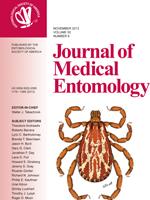The essential oil from aerial parts of Ruta chalepensis L. (Sapindales: Rutaceae) was obtained by hydrodistillation, and its chemical profile was identified using gas chromatography and gas chromatography-mass spectrometry. Compounds, 2-undecanone (43.2%), 2-nonanone (27.9%), and 2-nonyl acetate (10.6%) were the major constituents of the oil. Biting deterrent activity of R. chalepensis essential oil at 10 and 50 µg/cm2, 2-undecanone at 8.5 µg/cm2, 2-nonanone at 9 µg/cm2, and 2-nonyl acetate at 9.3 µg/cm2 was similar to DEET (N, N-diethyl-meta-toluamide) at 4.8 µg/cm2, against Aedes aegypti L. Biting deterrent activity of R. chalepensis oil at 50 µg/cm2 against Anopheles quadrimaculatus Say was statistically similar to DEET at 4.8 µg/cm2, whereas the activity was lower in the other compounds tested. In cloth patch assay, R. chalepensis essential oil was effective at 187 µg/cm2, whereas 2-undecanone was effective at 108.9 µg/cm2 against Ae. aegypti. In larval bioassays, 2-undecanone showed similar toxicity whereas toxicity of R. chalepensis essential oil and 2-nonanone was higher at 24-h posttreatment at the LD50 in An. quadrimaculatus than Ae. aegypti. This study revealed that R. chalepensis essential oil and its major compounds were active biting deterrents against Ae. aegypti at higher application rates whereas only the essential oil showed activity similar to DEET against An. quadrimaculatus. 2-undecanone was the most active compound in in vivo repellency bioassay against Ae. aegypti. Chemical composition of R. chalepensis essential oil varies because of plant production and harvest practices, and the activity level of the essential oil may depend on the source of the sample.
BioOne.org will be down briefly for maintenance on 17 December 2024 between 18:00-22:00 Pacific Time US. We apologize for any inconvenience.
How to translate text using browser tools
1 December 2013
Biting Deterrence, Repellency, and Larvicidal Activity of Ruta chalepensis (Sapindales: Rutaceae) Essential Oil and Its Major Individual Constituents Against Mosquitoes
Abbas Ali,
Betul Demirci,
Hulya Tuba Kiyan,
Ulrich R. Bernier,
Maia Tsikolia,
David E. Wedge,
Ikhlas A. Khan,
Kemal Husnu Can Başer,
Nurhayat Tabanca
ACCESS THE FULL ARTICLE
It is not available for individual sale.
This article is only available to subscribers.
It is not available for individual sale.
It is not available for individual sale.

Journal of Medical Entomology
Vol. 50 • No. 6
November 2013
Vol. 50 • No. 6
November 2013
Aedes aegypti
biting deterrent
larvicide
repellent
Ruta chalepensis




